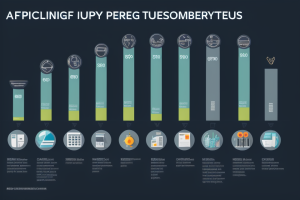
Energy intensity is a term used to describe the amount of energy required to produce a unit of output, such as a product or service. The debate surrounding energy intensity centers around whether businesses should strive to increase or decrease their energy intensity. In this article, we will explore both sides of the argument and examine the factors that influence a company’s energy intensity. We will also discuss the benefits and drawbacks of each approach and provide insights into how businesses can optimize their energy usage for maximum efficiency and profitability. So, whether you’re a business owner, manager, or simply interested in the topic, read on to find out more about the great energy intensity debate.
What is Energy Intensity?
Definition and Importance
Energy intensity refers to the amount of energy required to produce a unit of output, such as a product or service. It is a crucial metric for businesses as it helps them understand their energy consumption patterns and identify areas for improvement in terms of sustainability and cost reduction.
Higher energy intensity implies that more energy is needed to produce a unit of output, which can result in increased costs and a larger carbon footprint. On the other hand, lower energy intensity means that less energy is required to produce the same output, leading to cost savings and a smaller environmental impact.
For businesses, understanding and managing energy intensity is critical to ensuring long-term sustainability and competitiveness. As the world moves towards a more sustainable future, companies that can reduce their energy intensity and transition to renewable energy sources will be better positioned to succeed.
In the following sections, we will explore the debate around whether higher or lower energy intensity is better for businesses, and examine the factors that companies should consider when making decisions about energy consumption.
The Case for Higher Energy Intensity
Benefits and Advantages
- Increased productivity and efficiency: A higher energy intensity environment can drive businesses to adopt more advanced technologies and improve their processes, leading to increased productivity and efficiency. This, in turn, can help businesses to reduce costs, enhance their competitiveness, and better meet the demands of customers.
- Enhanced competitiveness and innovation: A higher energy intensity environment can spur innovation and drive businesses to develop new products and services. This can lead to a more competitive marketplace, as businesses strive to differentiate themselves and meet the changing needs of consumers. Additionally, businesses that are more energy efficient may be more attractive to investors, which can help them to secure funding and grow.
- Stimulating economic growth and job creation: A higher energy intensity environment can also contribute to economic growth and job creation. As businesses invest in new technologies and processes, they may need to hire additional workers to support these efforts. Additionally, businesses that are more energy efficient may be more attractive to customers, which can lead to increased sales and revenue. This, in turn, can create more job opportunities and contribute to overall economic growth.
Real-world Examples and Use Cases
Companies successfully adopting higher energy intensity strategies
Several companies have embraced higher energy intensity strategies, often resulting in improved operational efficiency and competitive advantage. For instance, Apple, a technology giant, has invested heavily in renewable energy sources to power its data centers. This strategy not only reduces the company’s carbon footprint but also minimizes its dependence on traditional energy sources, thus enhancing its energy security.
Another example is the automotive industry, where companies like Tesla and General Motors have shifted their focus towards electric vehicles (EVs). These EVs, with their higher energy intensity, have disrupted the market by offering better performance, lower emissions, and lower operating costs. As a result, these companies have gained a competitive edge in the industry, with Tesla becoming the world’s most valuable automaker.
Case studies demonstrating positive outcomes
Numerous case studies have been conducted to assess the impact of higher energy intensity strategies on businesses. One such study analyzed the energy consumption patterns of a large-scale manufacturing plant. The plant implemented an energy-efficient production process, which led to a 20% reduction in energy consumption. This reduction in energy intensity not only lowered the plant’s operating costs but also improved its environmental sustainability profile.
Another case study investigated the effectiveness of higher energy intensity strategies in the retail sector. A grocery store chain adopted energy-efficient lighting and HVAC systems, resulting in a 30% reduction in energy consumption. Consequently, the store experienced lower utility bills, improved employee productivity, and enhanced customer satisfaction due to a more comfortable shopping environment.
These real-world examples and case studies demonstrate that higher energy intensity strategies can offer numerous benefits to businesses, including cost savings, improved efficiency, and enhanced sustainability. By adopting these strategies, companies can gain a competitive edge in their respective industries and contribute to a more sustainable future.
The Case for Lower Energy Intensity
Reduced costs and environmental impact
Adopting energy-efficient practices and technologies can lead to significant cost savings for businesses in the long run. Lower energy intensity translates to reduced energy consumption, which directly impacts the bottom line by lowering energy bills. In addition, lower energy intensity also decreases the overall environmental impact of business operations, as it reduces greenhouse gas emissions and other forms of pollution. This can result in a positive reputation enhancement for companies that demonstrate a commitment to sustainability.
Improved sustainability and corporate social responsibility
Lowering energy intensity can contribute to improved sustainability and corporate social responsibility efforts. By consuming less energy, businesses are contributing to a more sustainable future and demonstrating their commitment to reducing their environmental footprint. This can be especially important for companies that rely on environmentally sensitive locations or that have a significant impact on the local environment. By adopting energy-efficient practices, businesses can mitigate some of the negative externalities associated with their operations and contribute to a more sustainable future.
Meeting regulatory requirements and industry standards
In many countries, businesses are subject to regulations and standards that mandate certain levels of energy efficiency. By adopting energy-efficient practices and technologies, businesses can ensure that they are meeting these requirements and avoid potential fines or penalties. In addition, many industries have voluntary standards or guidelines that encourage businesses to adopt energy-efficient practices. By adopting these practices, businesses can demonstrate their commitment to meeting industry standards and differentiate themselves as environmentally responsible companies.
Overall, the benefits and advantages of lower energy intensity for businesses are numerous and diverse. By adopting energy-efficient practices and technologies, businesses can reduce costs, improve sustainability, meet regulatory requirements, and enhance their reputation as responsible corporate citizens.
- Companies successfully adopting lower energy intensity strategies
- General Electric (GE)
- Implemented energy management programs
- Achieved a 34% reduction in energy intensity since 2011
- Procter & Gamble (P&G)
- Reduced energy intensity by 12% between 2010 and 2015
- Saved $1.4 billion in energy costs
- Unilever
- Set a target to reduce energy intensity by 20% by 2020
- Achieved a 12% reduction in energy intensity between 2008 and 2012
- General Electric (GE)
- Case studies demonstrating positive outcomes
- Intel
- Implemented energy-efficient technologies and practices
- Reduced energy intensity by 35% between 1999 and 2008
- Saved $3.3 billion in energy costs
- Walmart
- Implemented energy-efficient lighting and HVAC systems
- Reduced energy intensity by 28% between 2005 and 2010
- Saved $2.4 billion in energy costs
- Ford
- Implemented energy-efficient manufacturing processes
- Reduced energy intensity by 30% between 2000 and 2010
- Saved $1.2 billion in energy costs
- Intel
The Pros and Cons of Each Approach
Comparison of Key Factors
Financial Considerations
When considering the financial implications of higher or lower energy intensity for businesses, it is important to weigh the costs associated with each approach. A higher energy intensity may result in increased energy costs for a business, which can negatively impact its bottom line. On the other hand, a lower energy intensity may require a business to invest in new technologies or operational processes, which can have upfront costs that may not be immediately recovered.
Environmental Implications
The environmental implications of higher or lower energy intensity for businesses are also an important consideration. A higher energy intensity may result in increased greenhouse gas emissions and other environmental impacts, which can negatively impact a business’s reputation and regulatory compliance. On the other hand, a lower energy intensity may require a business to adopt cleaner and more sustainable energy sources, which can have positive environmental benefits.
Operational and Technological Factors
Finally, the operational and technological factors associated with higher or lower energy intensity for businesses must also be considered. A higher energy intensity may result in a more traditional and less efficient energy use, while a lower energy intensity may require a business to adopt new technologies and operational processes that can improve efficiency and reduce energy use.
In conclusion, the decision of whether to pursue a higher or lower energy intensity approach for a business depends on a variety of factors, including financial considerations, environmental implications, and operational and technological factors. It is important for businesses to carefully consider these factors when making decisions about their energy use and to balance the potential benefits and drawbacks of each approach.
Evaluating the Trade-offs
Balancing productivity and sustainability goals
One of the primary trade-offs when considering whether to adopt a higher or lower energy intensity approach is the balance between productivity and sustainability goals. A higher energy intensity approach may result in increased productivity in the short term, but it could have negative consequences for the environment and the long-term sustainability of the business. On the other hand, a lower energy intensity approach may result in a more sustainable business model, but it could potentially reduce productivity and profitability in the short term. Therefore, businesses need to carefully evaluate the trade-offs between these two goals when making decisions about their energy intensity.
Assessing the long-term viability of each approach
Another important trade-off to consider is the long-term viability of each approach. A higher energy intensity approach may result in higher profits in the short term, but it could also lead to higher costs and risks in the long term, particularly if the business is not able to adapt to changing environmental regulations or public expectations. In contrast, a lower energy intensity approach may require more investment in sustainable technologies and practices, but it could also lead to long-term cost savings and a more sustainable business model. Therefore, businesses need to carefully assess the long-term viability of each approach and consider the potential risks and benefits associated with each.
Key Takeaways and Recommendations
Understanding your specific energy needs and constraints
- Assess your current energy usage and identify areas where energy efficiency can be improved.
- Determine your energy intensity target based on your business goals and industry benchmarks.
- Consider implementing energy management systems and technologies to monitor and control energy usage.
Evaluating your industry and market dynamics
- Understand the energy requirements and regulations specific to your industry.
- Analyze market trends and customer demand to determine the optimal energy intensity for your business.
- Consider the competitive landscape and how your energy intensity compares to your competitors.
Identifying potential areas for improvement and growth
- Regularly review and update your energy management strategies to ensure they are aligned with your business goals.
- Identify opportunities for growth and expansion while maintaining energy efficiency.
- Seek out partnerships and collaborations with other businesses and organizations to share best practices and drive innovation in energy management.
Final Thoughts and Considerations
When it comes to energy management, there is no one-size-fits-all solution. Each business has unique energy needs and requirements, and the best approach will depend on a variety of factors. However, there are some general considerations that businesses should keep in mind when deciding whether to aim for higher or lower energy intensity.
- The importance of a holistic approach to energy management: Rather than focusing solely on reducing energy intensity, businesses should take a holistic approach to energy management. This means considering all aspects of energy use, from generation to consumption, and looking for opportunities to reduce waste and improve efficiency throughout the entire process.
- The role of technology and innovation in achieving optimal energy intensity: Technology and innovation can play a key role in helping businesses achieve their energy goals. This includes investing in energy-efficient equipment and appliances, implementing building automation systems, and utilizing renewable energy sources where possible.
- Future trends and developments to watch out for: As the world continues to shift towards more sustainable and renewable energy sources, businesses should stay up-to-date on the latest trends and developments in energy management. This includes keeping an eye on new technologies and innovations, as well as changes in regulations and policy that may impact energy use.
Overall, the best approach to energy management will depend on the specific needs and goals of each business. By taking a holistic approach and utilizing technology and innovation, businesses can achieve optimal energy intensity and support a more sustainable future.
FAQs
1. What is energy intensity?
Energy intensity refers to the amount of energy required to produce a unit of output, such as a product or service. It is typically measured in terms of energy consumption per unit of GDP or per unit of output. A higher energy intensity means that more energy is required to produce a unit of output, while a lower energy intensity means that less energy is required to produce the same output.
2. Why is energy intensity important for businesses?
Energy intensity is important for businesses because it can have a significant impact on their bottom line. Businesses that have a higher energy intensity may have higher energy costs, which can reduce their profitability. On the other hand, businesses that have a lower energy intensity may have lower energy costs, which can improve their profitability. Additionally, businesses that have a lower energy intensity may have a lower carbon footprint, which can be beneficial for their reputation and for meeting regulatory requirements.
3. Is higher or lower energy intensity better for businesses?
The answer to this question depends on the specific circumstances of the business. In general, businesses that have a lower energy intensity are more efficient and have lower energy costs, which can improve their profitability. However, businesses that have a higher energy intensity may have more opportunities to improve their efficiency and reduce their energy costs. Additionally, businesses that are in the energy production or extraction industries may have a higher energy intensity as a result of the nature of their operations.
4. How can businesses improve their energy intensity?
There are several ways that businesses can improve their energy intensity, including:
* Implementing energy efficiency measures, such as upgrading lighting or HVAC systems
* Using renewable energy sources, such as solar or wind power
* Implementing energy management systems to monitor and control energy use
* Encouraging employees to adopt energy-saving behaviors, such as turning off lights and electronics when not in use
* Investing in research and development to identify new technologies or processes that can improve energy efficiency
5. Are there any drawbacks to improving energy intensity?
Improving energy intensity can require significant investments in new technologies or processes, which can be costly for businesses. Additionally, some energy efficiency measures may require changes to business operations or employee behaviors, which can be difficult to implement. Finally, businesses that have a very low energy intensity may not have as much room for improvement, which may limit the potential benefits of energy efficiency initiatives.







